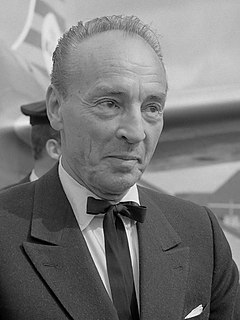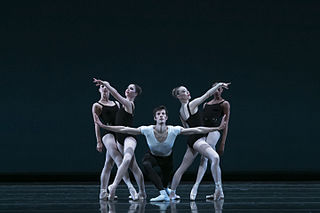Related Research Articles

George Balanchine was an American ballet choreographer who was one of the most influential 20th-century choreographers. Styled as the father of American ballet, he co-founded the New York City Ballet and remained its Artistic Director for more than 35 years. His choreography is characterized by plotless ballets with minimal costume and décor, performed to classical and neoclassical music.

Stars and Stripes is a neoclassical ballet choreographed by George Balanchine to music by John Philip Sousa, orchestrated by Hershy Kay. The ballet was made as a tribute to the United States, Balanchine's adopted country. It premiered on January 17, 1958, at the City Center of Music and Drama, danced by the New York City Ballet. It is dedicated to Fiorello La Guardia, former mayor of New York City. The ballet had been revived by multiple ballet companies, and at different special occasions.
John Taras was an American ballet master, repetiteur, and choreographer.
Tarantella is a ballet choreographed by George Balanchine to Grande Tarantelle by Louis Moreau Gottschalk, arranged by Hershy Kay. The ballet premiered on January 7, 1964, at the New York City Center, performed by New York City Ballet's Patricia McBride and Edward Villella.
Sean Lavery was a former principal dancer, balletmaster, and assistant to the balletmaster in chief at New York City Ballet. He was a répétiteur for the George Balanchine Trust and a former faculty member at the School of American Ballet.

Karin von Aroldingen Gewirtz was a German ballet dancer. She danced as a soloist at the Frankfurt Opera Ballet before joining the New York City Ballet in 1962 after receiving a personal invitation from George Balanchine. She was named as one of Balanchine's main beneficiaries in his will. Von Aroldingen retired from New York City Ballet in 1984, having reached the rank of principal dancer in 1972. In her later life she worked as a répétiteur for the Balanchine Trust, for which she was also a founder, staging his ballets for various companies.
Dance Preludes was a ballet made by Miriam Mahdaviani on New York City Ballet to Witold Lutosławski's 1955 music as a pièce d'occasion for the Dancers' Emergency Fund Benefit on 24 February 1991 at the New York State Theater, Lincoln Center. The program also included George Balanchine's Serenade, the pas de deux from his Theme and Variations, Robert La Fosse's Gretry Pas de Deux, Sean Lavery's Romeo and Juliet, Alexandre Proia's Salome Dances for Peace, and ended with Balanchine's Stars and Stripes.
Symphony in Three Movements is a neoclassical ballet choreographed by George Balanchine to the music of the same name by Stravinsky. The ballet was made for the New York City Ballet Stravinsky Festival in 1972, a tribute to the composer following his death. The ballet premiered on June 18, 1972, at the New York State Theater.
Brahms–Schoenberg Quartet is a one-act ballet by George Balanchine, to Johannes Brahms's Piano Quartet No. 1, orchestrated by Arnold Schoenberg. The ballet premiered on April 21, 1966 at the New York State Theater, performed by the New York City Ballet.
Kay Mazzo is an American former ballet dancer and educator. In 1961, she joined Jerome Robbins' company, Ballets USA. The following year, she joined the New York City Ballet, and was promoted to principal dancer in 1969. She created roles for George Balanchine and Robbins, before retiring from performing in 1981. She then joined the permanent faculty of the School of American Ballet in 1983, named Co-Chairman of Faculty in 1997 and Chairman of Faculty in 2018.

The Four Temperaments or Theme and Four Variations is an orchestral work and ballet by Paul Hindemith. Although it was originally conceived as a ballet for Léonide Massine, the score was ultimately completed as a commission for George Balanchine, who subsequently choreographed it as a neoclassical ballet based on the theory of the four temperaments.
Vienna Waltzes is a ballet choreographed by George Balanchine to music by Johann Strauss II, Franz Lehár and Richard Strauss, made as a tribute to Austria. It premiered on June 23, 1977 at the New York State Theater, performed by the New York City Ballet, and was an immediate success among the public.
Liebeslieder Walzer is a two-part neoclassical ballet choreographed by George Balanchine to Johannes Brahms' Liebeslieder Waltzes, Op. 52 and Neue Liebeslieder, Op. 65, with original sets and lighting designed by David Hays, and costumes designed by Barbara Karinska. The ballet premiered on 12 November 1960 at the New York City Center, performed by the New York City Ballet.
Los Angeles Ballet (LAB) is a classical ballet company based in Los Angeles. While rehearsals take place at the Los Angeles Ballet Center, the company tours venues across LA County, such as the Dolby Theatre and Royce Hall, during its performances. LAB typically hosts two classical ballets each season, with an additional Balanchine performance in the spring. The company was founded and is co-directed by husband-and-wife team Thordal Christensen and Colleen Neary. The company debuted December 2006 with an original performance of The Nutcracker.
Sally Harrington, known professionally as Sara Leland, was an American ballet dancer and répétiteur. She started her career with the Joffrey Ballet in 1959, and was recruited to join the New York City Ballet by George Balanchine in 1960. She was promoted to principal dancer in 1972, and created roles for both Balanchine and Jerome Robbins.
Paul Boos is an American dancer, balletmaster, archivist, and répétiteur. He danced with New York City Ballet from 1977 until 1990 before becoming a guest teacher for the Royal Danish Ballet. In addition to teaching internationally, he is part of a select group of répétiteurs sanctioned by the Balanchine Trust to set the ballets of George Balanchine and the Project Associate to the George Balanchine Foundation's Interpreters Archive.
Stravinsky Violin Concerto, originally titled Violin Concerto, is a neoclassical ballet choreographed by George Balanchine to Stravinsky's Violin Concerto. Balanchine had previously choreographed another ballet to the concerto in 1941 for the Original Ballet Russe, titled Balustrade, though it was not revived following a few performances. He then reused the concerto for New York City Ballet's Stravinsky Festival in 1972, a tribute to the composer following his death. The ballet premiered on June 18, 1972, at the New York State Theater.
Stephanie Saland is an American former ballet dancer and teacher. She was spotted by George Balanchine whilst a student at the School of American Ballet, then joined the New York City Ballet in 1972, and was promoted to principal dancer in 1984. She had created roles for both Balanchine and Jerome Robbins, before retiring in 1993. She then started teaching ballet in both the U.S. and internationally.
Duo Concertant is a ballet choreographed by George Balanchine to Stravinsky's score of the same name. The ballet was created for New York City Ballet's Stravinsky Festival, a tribute to the composer a year after his death, and premiered on June 22, 1972, at the New York State Theater, danced by Kay Mazzo and Peter Martins.
Maria Calegari is an American ballet dancer, teacher and répétiteur. She joined the New York City Ballet in 1974 and became a principal dancer in 1983. She left the company in 1994, then occasionally performed until 2004. She also teaches ballet and began working as a répétiteur for the Balanchine Trust and Robbins Rights Trust in 1996 and 2003 respectively.
References
- 1 2 3 4 Buckle, Richard (1988). George Balanchine: Ballet Master : a Biography. p. 296. ISBN 978-0-241-12180-1.
- ↑ Goldstein, Leon (May 6, 1984). "A Ballet Musician Recalls Balanchine". The New York Times.
- 1 2 3 4 5 Kisselgoff, Anna (January 28, 1978). "Balanchine's Kammermusik No. 2' Has Its Premiere at the City Ballet". The New York Times.
- 1 2 Taper, Bernard (1987). Balanchine: A Biography. ISBN 978-0-520-06059-3.
- ↑ Mead, Julia C. (October 2, 1997). "Karinn von AroldIngen: A Balanchine Disciple". East Hampton Star. Archived from the original on October 6, 2014.
- ↑ Macaulay, Alastair (May 2, 2012). "Balanchine's Gift for Joining What Nature Has Sundered". The New York Times.
- ↑ Bleiberg, Laura (February 22, 2010). "Dance review: Los Angeles Ballet's Balanchine program". Los Angeles Times.
- ↑ "Boston Ballet to Present Kaleidoscope, 3/17". BroadwayWorld. March 4, 2016.
- ↑ Ellis, Kathi E. B. (April 9, 2016). "Review: Louisville Ballet At Home With Balanchine". WFPL.
- ↑ Kisselgoff, Anna (February 13, 1984). "Dance: City Ballet's 'Kammermusik'". The New York Times.